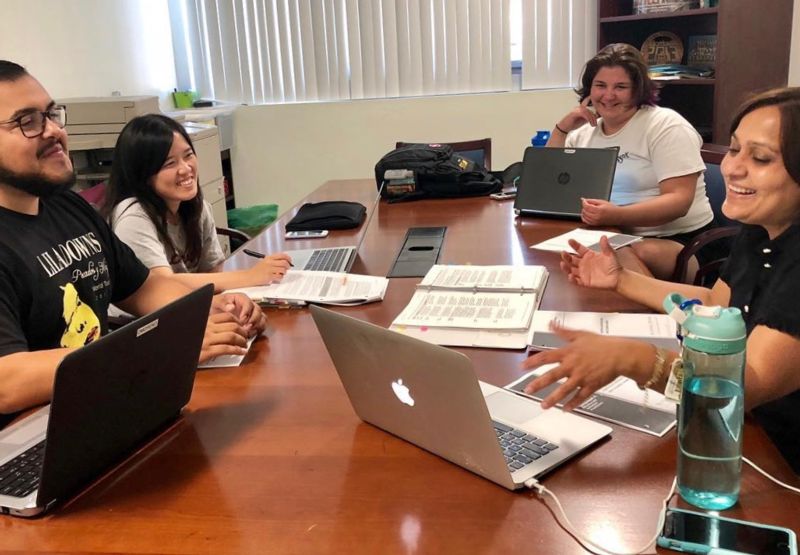Relationships, Reflection, and Results
How Bright Star’s High Performing Teacher Yogeshwari Patel Helped 100% of her Students to Pass the AP Biology Exam

Yogi Patel (right) coaches Bright Star teachers who are pursuing National Board Certification
By Kendra Racouillat
Last spring, only 40% of Yogeshwari (Yogi) Patel’s Valor Academy High School juniors were on track to pass their Advanced Placement (AP) Biology test, based on their spring midterm assessment. Yet only a month and a half later, 100% of Yogi’s students passed the AP Biology College Board exam.
Yogi wasn’t surprised. She’d known from day one that every student could succeed, and she’d employed her standard approach of high expectations, trust, support, and data analysis to get there.
Though Yogi wasn’t surprised that all five of her AP Biology students passed their AP tests, she was delighted. When she received the results, “It was the happiest day of my summer break,” she says.
Yogi is one of Bright Star Schools’ high-performing teachers. Now in her 11th year as a Bright Star Teacher (with seven years at Bright Star Secondary Charter Academy and now in her fourth year at Valor Academy High School), Yogi is also a National Board Certified teacher.
Last year, she received a scholarship from Bright Star to pursue National Board Certification, a non-mandatory, nationally recognized, rigorous teacher credential beyond state licensure. As a National Board Certified teacher, Yogi is part of an elite group of teachers; nationwide, just under 3% of teachers are National Board Certified.
“It feels really good to be National Board Certified. It’s the highest honor you can have in the teaching career,” Yogi says. “I’m glad I did it, and without the Bright Star scholarship, I might not have done it.”
Yogi is passionate about her work, and found her best teaching fit with high school students.
“With high school students, I can have high expectations,” Yogi explains. “At their age, they’re about to grow into adults, so you can push them. But before you can have high expectations, you have to be clear about what you want from your students and what skills you want to see from them.”
In fact, high expectations are a part of Yogi’s successful approach to teaching, which also includes knowing her students well, setting high expectations, and continually reflecting. The foundation for her approach is trust.
“To build trust, you have to give time to relationships, be patient, and try to understand each student,” Yogi elaborated. “The more you know about your students, the more you trust them, and the more they trust you.”
In fact, trust played a big part in Yogi’s and her students’ success in passing their AP Biology tests.
“Our students have that willingness to learn and succeed. Initially, they fear they won’t be able to do it,” Yogi says. “Every day, I made my students believe that passing the AP Biology test was something that they could do. Not all of them are star, gifted students, but I know they can do it. I help them through their struggles and make them believe they can do it. Every single day.”
Over time, Yogi says, her students start to believe in their abilities and what they could accomplish -- because they trusted Yogi.
“The day-to-day work with my students, knowing them, and reflecting on those relationships builds teamwork between teacher and student,” she explains. “Because of those strong relationships, they trusted me a lot. They say to me, ‘Miss, whatever you say.’ And I push them a lot but I wouldn't be able to succeed if the students didn’t trust me.”
For her students to reach the high expectations she had for them, Yogi set a clear path for them to get there and ensured they had enough time.
First, Yogi started her AP Bio sessions in the second week of school to give her students as much learning and practice time as possible. She scheduled an after-school session each Friday so that she and her students could work together at a slower pace. She scheduled extra sessions as needed up until and during Spring Break.
Second, she kept the rigor high. “All of my tests are like mini versions of AP tests. I use test questions from previous AP exams so that from the very first test, the students get practice and are exposed to rigorous questions,” she says.
After students take the practice exams, Yogi dives into the data analysis. “I convert their scores into a raw AP score and I can tell where they are. After their spring midterm, which is a mock AP-test, we have a month and a half to work,” she says.
Yogi could see what concepts her students were lagging behind on and then scheduled multiple days of tutoring. She had her students take another mock-AP in April, and another in May.
“They all passed the mock AP in April, and the one in May. There’s a lot to analyze and reflect on from the mock AP results, and then focus on the areas of need,” she says. “I knew by May that they could all pass the exam.”
For Yogi, passing the AP exam itself is only small part of the benefit of an AP class. Overall, it’s about preparing students to succeed in college, which is especially critical for Bright Star students as many will be the first in their families to graduate from higher education.
“AP classes give students an overview of how college courses will be. The rigor will be the same,” Yogi says. “Students also build many skills like how to study, time management, and where to look for resources. It’s important for our kids to have that when they go to college.”
Yogi credits the support she’s able to give to her students with the support she receives as a teacher.
“At Bright Star, there is support for everyone. Everyone works together,” she says. “Trust is everywhere and building relationships is the most important thing.”
* http://www.ncsl.org/Portals/1/Documents/educ/NationalBoard.pdf http://www.ncsl.org/Portals/1/Documents/educ/NationalBoard.pdf


